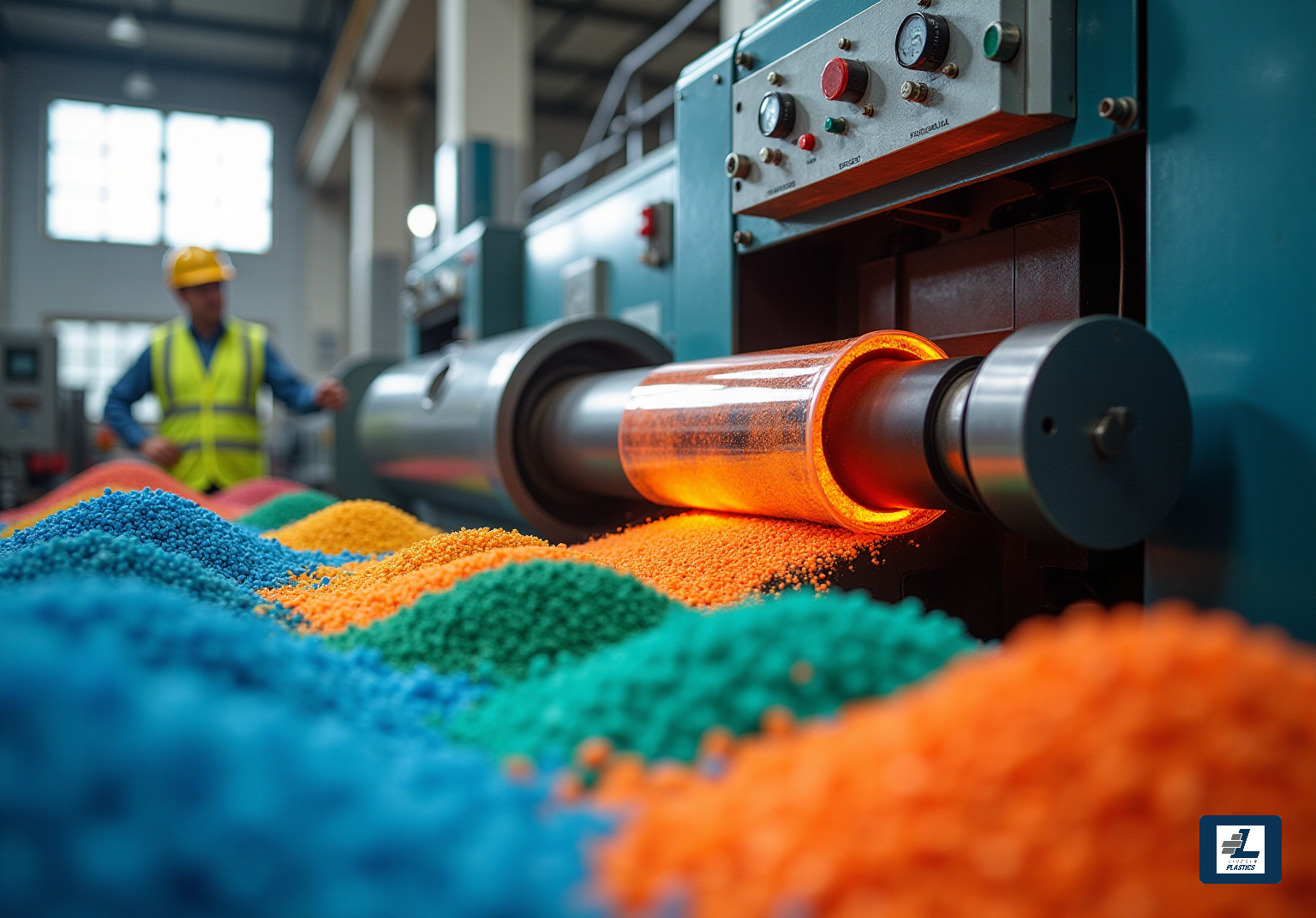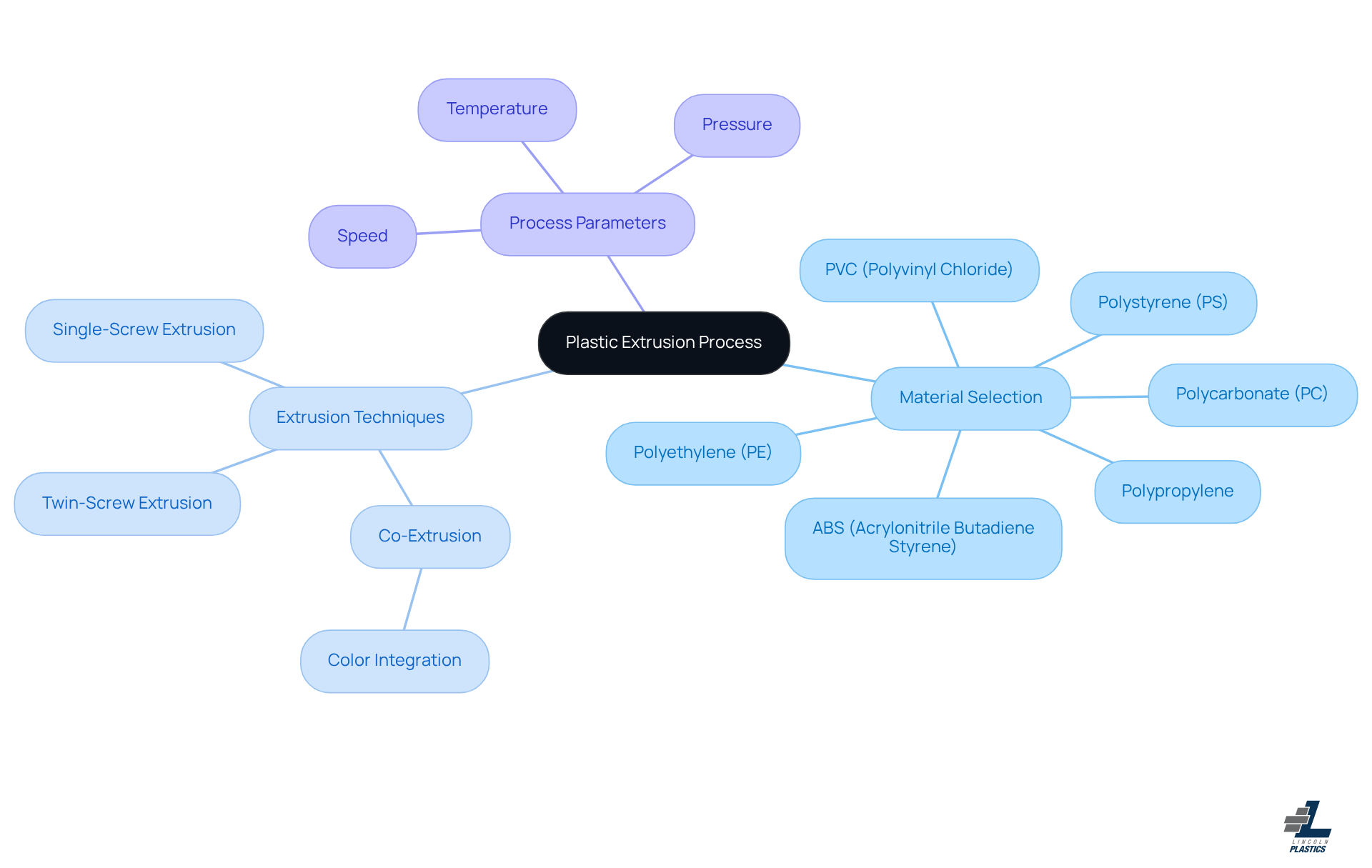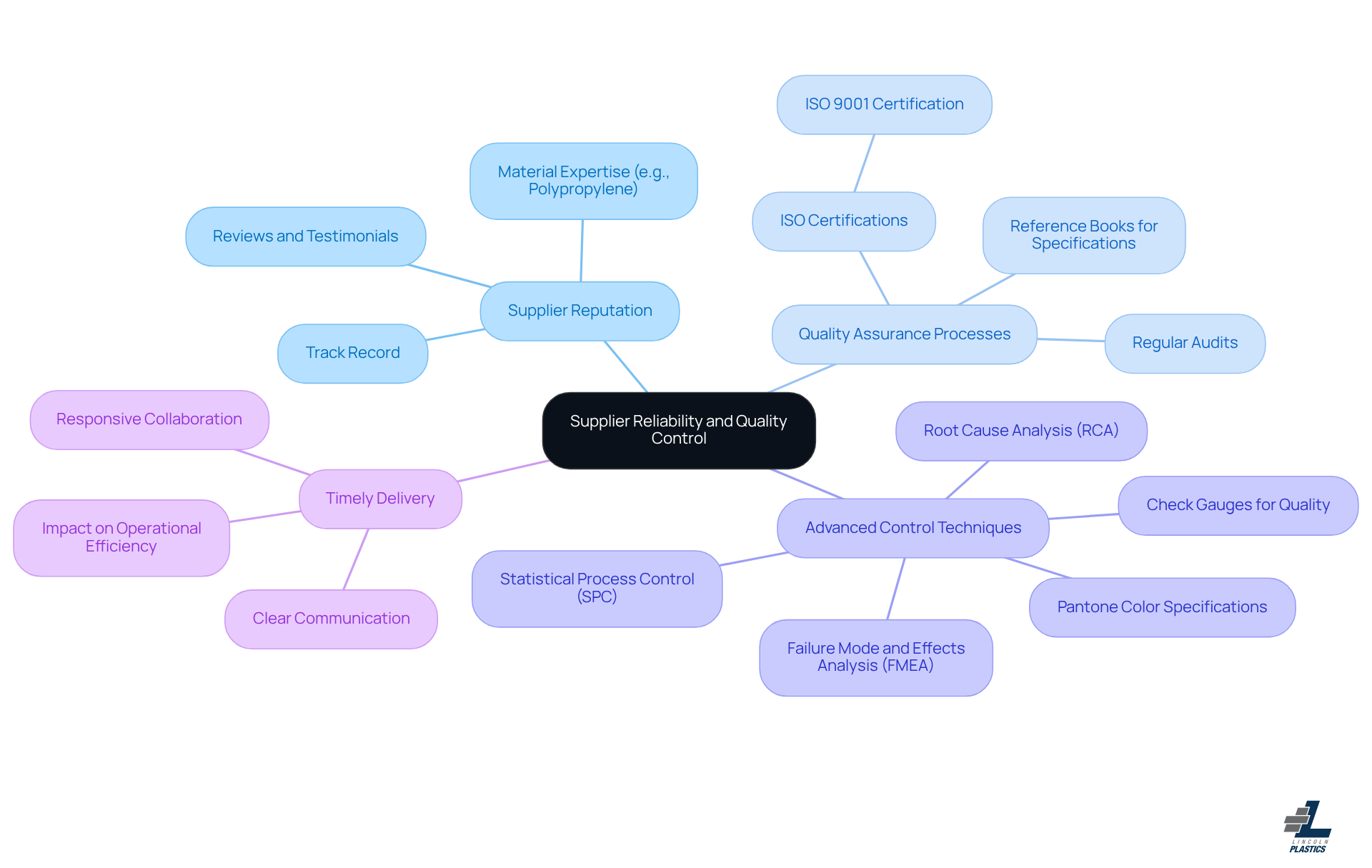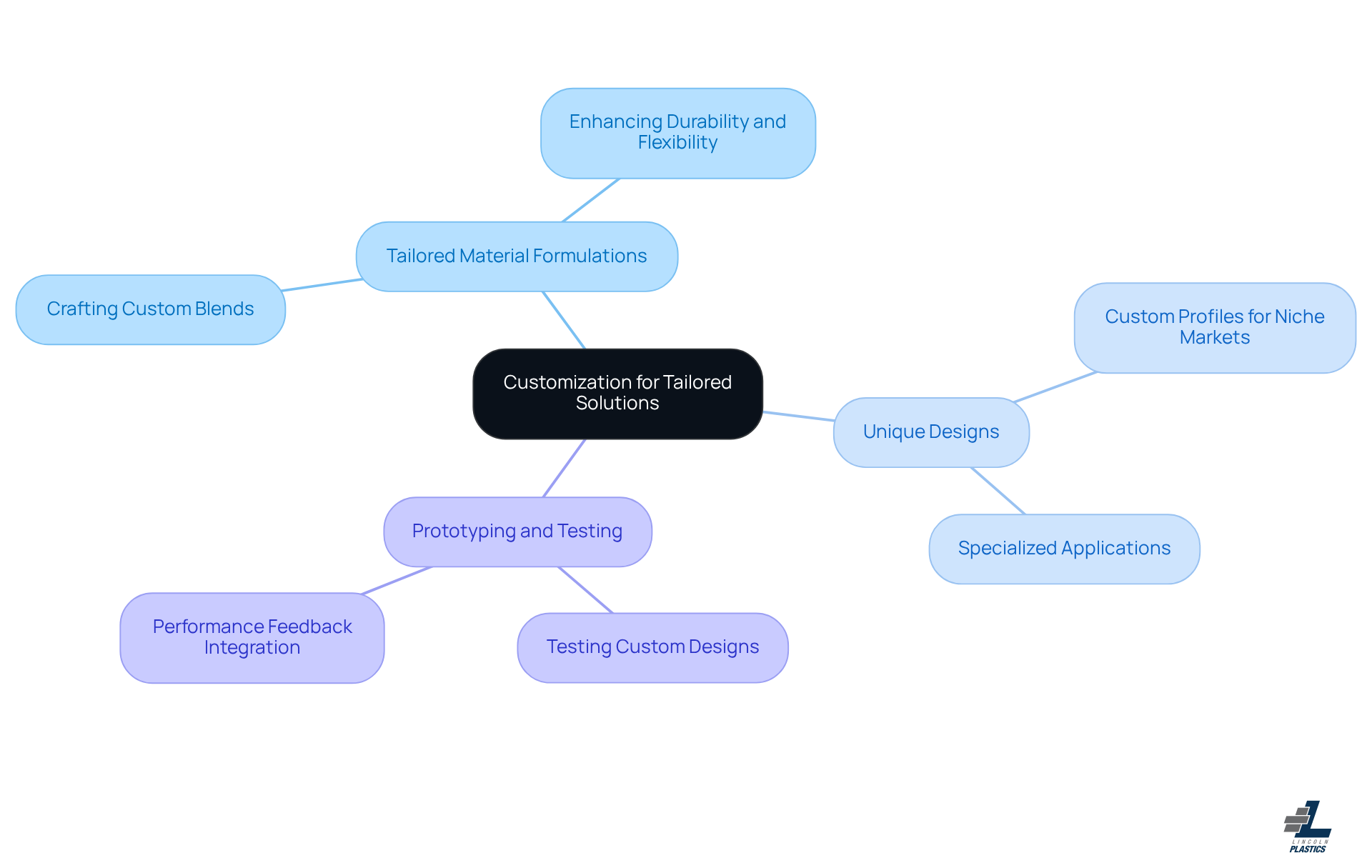
4 Best Practices for Sourcing Extruders Plastic Effectively
Overview
When it comes to sourcing plastic extruders, there are some best practices that can really make a difference. First off, understanding the extrusion process is key. Have you ever thought about how many different types of extruders are out there? Evaluating these options is super important, too. And let’s not forget about supplier reliability and quality control—those should be top priorities!
Now, you might be wondering how customization fits into all of this. Leveraging tailored solutions can really set your business apart. By mastering these elements, you’ll be able to communicate your needs clearly. This means you can select the right technologies that ensure high-quality production.
Ultimately, it’s all about creating unique products that meet specific market demands. So, why not dive in and explore these practices? You’ll find that they not only enhance your understanding but also help you make informed decisions that lead to success!
Introduction
Understanding the ins and outs of sourcing plastic extruders can feel like a puzzle for manufacturers looking to boost their production game. With the right insights, you can not only improve product quality but also make your operations smoother and cut down on costs. But let’s be honest—navigating the maze of different extruder types, reliable suppliers, and customization options can be a bit overwhelming.
So, what if I told you there are key practices that can turn these sourcing challenges into strategic advantages? In the competitive world of plastic extrusion, having the right approach can make all the difference. Let’s dive in and explore how you can transform your sourcing strategy!
Understand the Plastic Extrusion Process
To effectively source extruders, it’s super important to get a grasp on the complexities of the extrusion process. This means understanding how unprocessed synthetic substances turn into finished products through heating, melting, and shaping. Let’s break down some key components:
-
Material Selection: Did you know that different plastics have unique properties? This affects their suitability for various applications. Familiarize yourself with materials like PVC, polyethylene, and polypropylene to make informed choices. Lincoln Plastics has a range of sizes and materials for flexible profiles, so you can find just the right fit for your needs.
-
Extrusion Techniques: Now, let’s talk about the different extrusion methods, like single-screw and twin-screw extrusion. Each has its own impact on the item’s characteristics. Our co-extrusion solutions even allow for the integration of different colors into profiles, giving you more options for customization.
-
Process Parameters: You might be wondering how temperature, pressure, and speed influence the extrusion process and the quality of the final product. Adjusting these parameters can lead to significant improvements in efficiency and output. At Lincoln Plastics, we take pride in delivering mission-critical rigid extrusion components on time, ensuring reliability in your supply chain.
By mastering these elements, you can better communicate your requirements regarding extruders plastic to potential suppliers. This way, you’ll ensure that the selected extruders can effectively meet your specific operational needs.

Evaluate Different Types of Plastic Extruders
When you're on the hunt for extruders plastic, it’s super important to check out the different types available. Let’s break it down:
-
Single-Screw Extruders: These are the go-to option for many, perfect for a variety of materials. They shine in continuous production environments but might hit a snag with complex formulations that need a lot of mixing or precise temperature control. The best part? They usually have lower operational costs compared to twin-screw extruders, making them a favorite for manufacturers sticking to standard recipes.
-
Twin-Screw Extruders: These guys are known for their versatility! They can handle a broader range of substances, including heat-sensitive or high-viscosity materials. If you’re into compounding and blending, they really excel, giving you better control over the characteristics of your substances. This is especially key for crafting specialty polymers and masterbatches. At Lincoln Plastics, we take this seriously—ensuring that everything we extrude meets strict specifications through thorough checks and detailed documentation. Sure, they might cost a bit more, but their performance and efficiency often make it worth it, especially when you need high throughput and flexibility.
-
Co-Extruders: Now, these systems let you extrude different substances at the same time. This means you can create products with unique properties and improved performance. They’re especially handy for applications that need specific surface features, like better barrier properties or eye-catching finishes. We work closely with OEMs to customize these solutions, ensuring the final products not only meet but exceed expectations. Plus, we can easily source colors that match your Pantone specs for consistency across all manufacturers.
Understanding the pros and cons of each type really helps you pick the right extruders plastic that fits your production goals and material needs. And let’s not forget, new developments in extruder technology are always popping up, so it’s crucial to stay updated on the latest advancements in the field. What do you think? Are you ready to dive deeper into the world of extruders plastic?

Prioritize Supplier Reliability and Quality Control
In the world of extruders plastic, it’s super important to focus on reliable suppliers and effective control measures to ensure top-notch production results. Let’s dive into some key considerations:
- Supplier Reputation: First off, check out potential suppliers’ track records. You want to know they have a history of delivering quality products on time. Reviews, testimonials, and case studies can give you valuable insights into their reliability and performance. For instance, a supplier that excels in materials like polypropylene (PP) is a big plus, thanks to its high tensile strength, chemical resistance, and thermal stability, which can really boost product durability.
- Quality Assurance Processes: Next, make sure your suppliers have solid quality control measures in place. Look for things like ISO certifications—Lincoln Plastics has an ISO 9001 certification—and regular audits. This helps ensure that materials and processes meet industry standards, cutting down the risk of defects and production delays. Plus, having a specialized reference book for synthetic profiles, complete with illustrations and essential in-process checks, helps keep specifications on point.
- Advanced Control Techniques: Now, let’s talk about advanced control techniques. Techniques like Statistical Process Control (SPC), Failure Mode and Effects Analysis (FMEA), and Root Cause Analysis (RCA) are key for maintaining high standards in the manufacturing of extruders plastic. Lincoln Plastics uses various check gauges to ensure a proper end-use fit, helping to spot potential issues before they escalate. And sourcing colors that align with Pantone specifications can really enhance consistency across manufacturers.
- Timely Delivery: It’s also crucial to establish clear communication with your suppliers to tackle any issues quickly. A dependable supplier, like Lincoln Plastics, should be responsive and ready to collaborate on solutions. Timely delivery is essential for smooth manufacturing processes and meeting production deadlines, which can significantly impact overall operational efficiency.
By honing in on these aspects, businesses can reduce risks tied to sourcing plastic extruders and pave the way for a smoother production process. Integrating case studies that showcase the impact of quality control in polymer extrusion can provide real-world examples of the concepts we’ve discussed. Plus, don’t forget that considering sustainability and eco-friendly practices in your supplier selection is becoming increasingly important for modern businesses, aligning with broader environmental goals.

Leverage Customization for Tailored Solutions
Customization in extruders plastic is crucial for boosting performance and effectively catering to client needs. So, let’s dive into some key strategies you might want to think about:
- Tailored Material Formulations: Have a chat with your suppliers about crafting custom material blends. This can really amp up performance traits like durability and flexibility, making sure it fits those specific applications.
- Unique Designs: Team up with extruders to whip up custom profiles that target niche markets or specialized applications. This way, your offerings will really shine in a crowded marketplace.
- Prototyping and Testing: Don’t skip out on prototyping services! They can help you test out custom designs before going full-scale. This means you can tweak things based on performance feedback, ensuring the final product meets your expectations.
By putting customization front and center, businesses can not only meet operational needs but also set themselves apart in the market. This ultimately leads to happier customers and builds loyalty.

Conclusion
Mastering the art of sourcing plastic extruders is crucial for businesses looking to boost their production efficiency and product quality. You might be wondering how to navigate this process. Well, understanding the ins and outs of plastic extrusion, evaluating different types of extruders, prioritizing reliable suppliers, and embracing customization are all key elements that make for successful sourcing strategies. By focusing on these aspects, companies can ensure they meet their operational needs while creating standout products in a competitive market.
Now, let’s dive into some key insights shared throughout this article. We’ve talked about the importance of selecting the right materials, the benefits of various extrusion techniques, and the need for strict quality control measures. Understanding the differences between single-screw, twin-screw, and co-extruders is essential for making informed decisions based on your production goals. Plus, building strong relationships with dependable suppliers and exploring customization options can significantly boost product performance and customer satisfaction.
In today’s fast-paced industry, staying updated on the latest advancements and best practices in plastic extrusion is vital. Businesses should actively seek opportunities for innovation and improvement, ensuring their sourcing strategies align with broader environmental goals and market demands. By implementing these best practices, organizations can not only optimize their production processes but also cultivate a reputation for quality and reliability in the plastic extrusion sector. So, are you ready to take your sourcing strategies to the next level?
Frequently Asked Questions
What is the plastic extrusion process?
The plastic extrusion process involves transforming unprocessed synthetic substances into finished products through heating, melting, and shaping.
Why is material selection important in the extrusion process?
Different plastics have unique properties that affect their suitability for various applications. Familiarizing yourself with materials like PVC, polyethylene, and polypropylene helps in making informed choices for specific needs.
What are the different extrusion techniques?
The main extrusion techniques include single-screw and twin-screw extrusion, each impacting the characteristics of the final product. Co-extrusion solutions also allow for the integration of different colors into profiles for customization.
How do process parameters affect the extrusion process?
Temperature, pressure, and speed are critical process parameters that influence the extrusion process and the quality of the final product. Adjusting these parameters can lead to significant improvements in efficiency and output.
How can understanding the extrusion process help in sourcing extruders?
By mastering the key components of the extrusion process, you can better communicate your requirements to potential suppliers. This ensures that the selected extruders can effectively meet your specific operational needs.
List of Sources
- Understand the Plastic Extrusion Process
- News - The Impact of Material Selection on Plastic Extruder Performance: Choosing the Right Resin (https://qiangshengplas.com/news/the-impact-of-material-selection-on-plastic-extruder-performance-choosing-the-right-resin)
- Choosing Materials for Plastic Extrusion - PET (https://plasticextrusiontech.net/choosing-the-right-materials-for-plastic-extrusion)
- Best Practices for the Extrusion of Polymers in Manufacturing (https://lincoln-plastics.com/news-post/best-practices-for-the-extrusion-of-polymers-in-manufacturing?dcc2137a_page=12)
- The influence of material properties and process parameters on energy consumption during extrusion of flexible PVC (https://sciencedirect.com/science/article/pii/S2214993723002178)
- A Guide to Material Selection for Extrusion | Inplex LLC (https://inplexllc.com/blog/a-guide-to-material-selection-for-extrusion)
- Evaluate Different Types of Plastic Extruders
- Single-Screw vs Twin-Screw Food Extruders: Key Differences (https://petreatsmachine.com/single-vs-twin-screw-food-extruder)
- Key Points to pay attention to when selecting plastic extruder - Cowin Extrusion (https://cowinextrusion.com/key-points-to-pay-attention-to-when-selecting-plastic-extruder)
- What Are The Differences Between Single And Twin Screw Extruders? (https://eupegypt.com/blog/differences-between-single-and-twin-screw-extruders)
- Exploring the Differences: Single Screw Extruder and Twin Screw Extruder (https://ud-machine.com/blog/difference-between-single-and-twin-screw-extruder)
- A Comprehensive Comparison of Single and Twin Screw Extruders - Nanjing KY Chemical Machinery Co., Ltd. (https://keyatwinscrew.com/a-comprehensive-comparison-of-single-and-twin-screw-extruders.html)
- Prioritize Supplier Reliability and Quality Control
- Key Points to pay attention to when selecting plastic extruder - Cowin Extrusion (https://cowinextrusion.com/key-points-to-pay-attention-to-when-selecting-plastic-extruder)
- 4 Best Practices for Choosing a Reliable Plastic Extrusion Supplier (https://lincoln-plastics.com/news-post/4-best-practices-for-choosing-a-reliable-plastic-extrusion-supplier)
- 5 Qualities to Look for in a Plastics Supplier - CTC Plastics (https://ctcplastics.com/2024/04/5-qualities-to-look-for-in-a-plastics-supplier)
- The Importance of Quality Control in Plastic Extrusion Manufacturing - Craftedplastics (https://craftedplastics.com/blog/the-importance-of-quality-control-in-plastic-extrusion-manufacturing)
- Leverage Customization for Tailored Solutions
- Cherry Pipes & TSM Control Systems: A Partnership in Sustainability – TSM Controls Systems (https://tsm-controls.com/blog/case_studies/cherry-pipes-tsm-control-systems-a-partnership-in-sustainability)
- Custom Plastic Extrusion Case Studies | SFR Industries (https://sfrindustries.com/case_studies)


